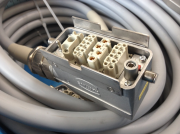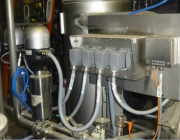 The traditional use of hard wiring has previously been an acceptable form of connecting electrical circuits. However, this is a time consuming and expensive installation process ensuring every element is wired correctly and tested.
The traditional use of hard wiring has previously been an acceptable form of connecting electrical circuits. However, this is a time consuming and expensive installation process ensuring every element is wired correctly and tested.
Additionally, this presents a number of costly challenges when faults or breakdowns occur. Using hard-wired solutions requires an engineer to diagnose and fix the problem, during which the equipment is not functioning resulting in lost time, reduced production and incurred costs.
Using Plug and Play as an alternative connection technology, offers a cost effective and efficient solution. By wiring the product through connectors, it becomes possible to connect to and disconnect from the electrical circuit effortlessly.
 Moving the production off-site, the installation time can be reduced from days and potentially weeks for off-site wind turbines to a matter of hours. HARTING Plug and Play solutions provides reliable cable assemblies and box builds with market leading connectors that can survive even the harshest environments including; extreme temperatures, water, and salt.
Moving the production off-site, the installation time can be reduced from days and potentially weeks for off-site wind turbines to a matter of hours. HARTING Plug and Play solutions provides reliable cable assemblies and box builds with market leading connectors that can survive even the harshest environments including; extreme temperatures, water, and salt.
Rapid replacement of systems is also of particular significance for wind turbines. As a preferential supplier to the wind energy industry offering an extensive and highly diverse line of connectors for a wide range of applications, HARTING is making a key contribution. The respective product spectrum extends from high-current components for applications through to 650 A to solutions for data and bus transfer such as the RJ 45 in industrial housings.
 The function of energy generation poses the multiple problem to connect high currents and voltages. If the connection is to be made pluggable, an extremely high current connection from the HC Modular line is advantageous. With a current-carrying capacity of up to 650 A at voltages up to 4 kV, such multiple-pin plug connections in conjunction with HPR housings (HPR: High Pressure Resistant) can be combined to form extremely robust systems.
The function of energy generation poses the multiple problem to connect high currents and voltages. If the connection is to be made pluggable, an extremely high current connection from the HC Modular line is advantageous. With a current-carrying capacity of up to 650 A at voltages up to 4 kV, such multiple-pin plug connections in conjunction with HPR housings (HPR: High Pressure Resistant) can be combined to form extremely robust systems.
High-performance, reliable connections for data exchange and local power supply are still the most basic requirements in implementing a modern control system. Operating, monitoring, and programming units are usually networked via the widely used RJ 45 interface. For wider-ranging requirements for shielding within the connection, the Han-Quintax® is advisable. This plug connection allows secure data exchange of sensitive signals, e.g. for bus systems (transmission rate: 100 Mbit/s) based on a coaxial plug connection.
 The fibre-optic connections widely used for networking must be designed to be pluggable for different optical fibre types and also meet the requirements described above. The SC module allows the integration of standard SC connectors from different vendors into one module from the Han-Modular® line. With the “snap-in” technique, up to 4 fibre-optic connections (50/125 µm; 62.5/125 µm) can be installed in the SC module without any additional tools and can be removed just as easily. Thanks to a host of installation options, such as a Han-Compact® housing, this connection also achieves a protection type of at least IP 65.
The fibre-optic connections widely used for networking must be designed to be pluggable for different optical fibre types and also meet the requirements described above. The SC module allows the integration of standard SC connectors from different vendors into one module from the Han-Modular® line. With the “snap-in” technique, up to 4 fibre-optic connections (50/125 µm; 62.5/125 µm) can be installed in the SC module without any additional tools and can be removed just as easily. Thanks to a host of installation options, such as a Han-Compact® housing, this connection also achieves a protection type of at least IP 65.
As an active connector, the interface of a hybrid connector, as defined in the DESINA standard, offers transmission of fibre optic signals and a galvanic connection with up to five 10 A contacts, also for bus power supply. The fibre-optic connection – which can be designed for POF and HCS – allows transmission rates via an HCS fibre of up to 12 Mbit/s at a maximum distance of 300 m. The maximum cable length of the plastic fibre version is 50 m.
Discover how customised solutions from HARTING can help you.
Visit the website http://www.harting.co.uk/customised-cables/ for products, applications and solutions.
Tel; 01604 827500
Email; salesuk@HARTING.com


